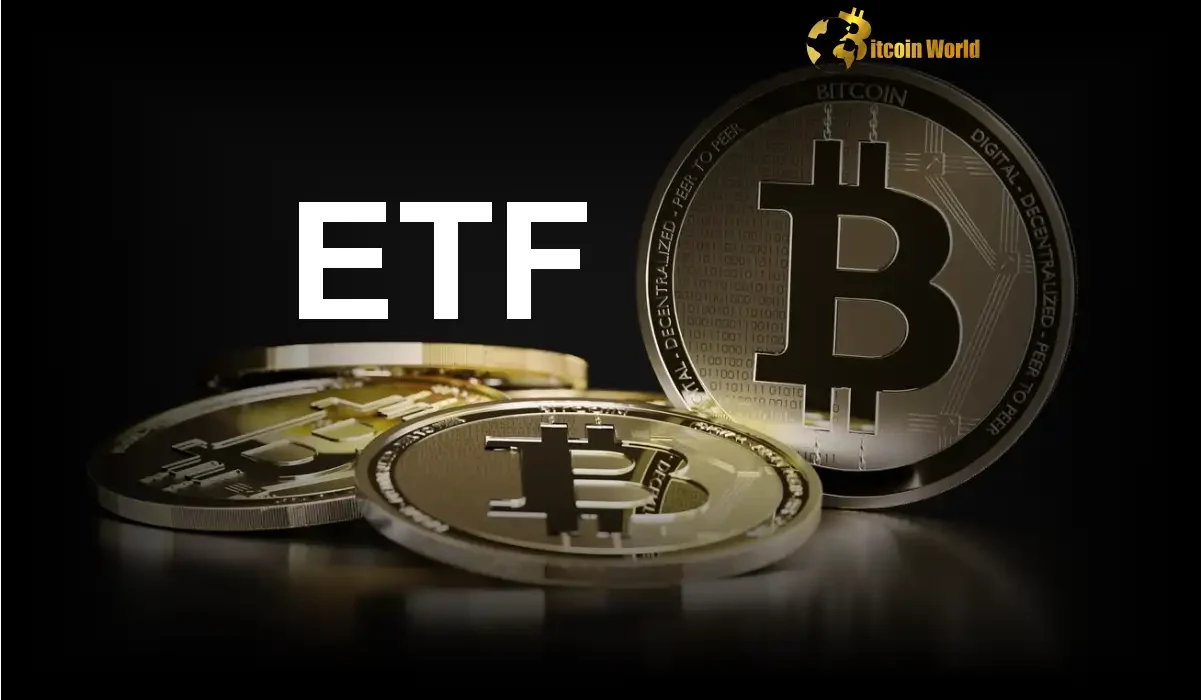Just when the crypto world seemed to be finding its footing, a fresh wave of unease has swept through the U.S. spot Bitcoin ETF market. Recent data reveals a significant net outflow of $60.44 million from these investment vehicles on March 31st. This marks the second consecutive day of net negative flows, raising eyebrows and prompting questions about investor sentiment and the sustainability of the Bitcoin ETF euphoria. Let’s dive deep into what these Bitcoin ETF outflows signify and what could be driving this trend.
Decoding the Latest Bitcoin ETF Outflows: A Snapshot
According to crypto data aggregator Trader T (@thepfund) on X, the last day of March painted a concerning picture for several spot Bitcoin ETFs. While BlackRock’s IBIT managed to buck the trend, the majority experienced notable ETF outflows. Here’s a quick breakdown:
- WisdomTree’s BTCW: Led the outflows with a substantial $32.5 million exiting the fund.
- ARK Invest’s ARKB: Followed closely with $23.18 million in net outflows.
- Bitwise’s BITB: Recorded $19.87 million in net outflows.
- BlackRock’s IBIT: The silver lining, posting a net inflow of $15.16 million.
- Remaining ETFs: Reported no change in holdings, indicating neither inflows nor outflows.
This collective net outflow of $60.44 million underscores a shift in momentum. After weeks of consistent inflows, the tide seems to be turning, at least for now. But what factors are contributing to these spot Bitcoin ETFs seeing red?
Why are Spot Bitcoin ETFs Experiencing Outflows?
Several factors could be at play, influencing investors to pull back from Bitcoin ETFs:
- Profit Taking: After a significant run-up in Bitcoin’s price and the corresponding ETF values, some investors might be locking in profits. This is a common market behavior, especially after periods of strong gains. Investors who bought in early might see this as an opportune moment to realize returns.
- Market Correction Fears: The cryptocurrency market is known for its volatility. Concerns about a potential market correction could be prompting investors to reduce their exposure to Bitcoin, leading to outflows from ETFs as a readily accessible exit point.
- Macroeconomic Uncertainty: Broader economic factors, such as inflation concerns, interest rate hikes, or geopolitical events, can impact investor sentiment across all asset classes, including cryptocurrencies. Uncertainty often leads to risk aversion, and Bitcoin, despite its growing mainstream acceptance, is still considered a risk asset by many.
- ETF Rotation: It’s possible that investors are reallocating their capital within the ETF landscape. The flows into IBIT, while others experienced outflows, suggest that investors might be shifting preferences between different Bitcoin ETFs, possibly towards those with lower fees or stronger brand recognition like BlackRock.
- End-of-Quarter Rebalancing: March 31st marked the end of the first quarter. Institutional investors and fund managers often rebalance their portfolios at the end of quarters. This rebalancing could involve adjusting their cryptocurrency holdings, potentially leading to temporary outflows from Bitcoin ETFs.
BlackRock’s IBIT: A Beacon of Inflows Amidst the Outflow Tide
Interestingly, amidst the widespread Bitcoin ETF outflows, BlackRock’s IBIT stood out as the sole ETF attracting net inflows. This inflow of $15.16 million suggests a few possibilities:
- Investor Confidence in BlackRock: BlackRock’s reputation as a leading asset manager might be instilling greater confidence among investors, even during periods of market uncertainty. Investors might perceive IBIT as a safer or more reliable option compared to newer or smaller ETF providers.
- Strategic Accumulation: Some investors might view the overall market dip and the outflows from other ETFs as a buying opportunity. They could be strategically accumulating Bitcoin through IBIT, anticipating a future market rebound.
- Long-Term Investment Strategy: Investors with a long-term bullish outlook on Bitcoin might be using temporary market dips to increase their holdings in IBIT, focusing on the long-term potential of Bitcoin rather than short-term market fluctuations.
Actionable Insights: Navigating Bitcoin ETF Volatility
For investors navigating the choppy waters of crypto investment in Bitcoin ETFs, here are some actionable insights:
- Don’t Panic Sell: Short-term outflows are not necessarily indicative of a long-term trend reversal. Market corrections and profit-taking are normal parts of market cycles. Avoid making impulsive decisions based on short-term fluctuations.
- Diversify Your Portfolio: Bitcoin ETFs should ideally be part of a diversified investment portfolio. Don’t put all your eggs in one basket. Diversification helps mitigate risk and can improve overall portfolio stability.
- Focus on Long-Term Fundamentals: Assess your investment thesis for Bitcoin and Bitcoin ETFs. Are you a long-term believer in the technology and its adoption? Focus on the long-term fundamentals rather than getting swayed by short-term market noise.
- Monitor ETF Flows: Keep an eye on ETF flow data, but interpret it in context. Look for trends over longer periods rather than reacting to daily fluctuations. Tools and platforms that track ETF flows can provide valuable insights into market sentiment.
- Stay Informed: The cryptocurrency market is dynamic. Stay updated on market news, regulatory developments, and macroeconomic factors that could impact Bitcoin and Bitcoin ETFs. Informed decisions are always better decisions.
Conclusion: Decoding the Bitcoin ETF Signal
The recent Bitcoin ETF outflows serve as a reminder of the inherent volatility in the cryptocurrency market. While concerning, they are not necessarily a cause for alarm. Understanding the potential drivers behind these outflows, such as profit-taking, market correction fears, and end-of-quarter rebalancing, provides valuable context. The contrasting inflow into BlackRock’s IBIT also highlights nuances within the ETF market itself. For investors, the key is to maintain a long-term perspective, stay informed, and avoid knee-jerk reactions to short-term market fluctuations. The journey of spot Bitcoin ETFs is still in its early stages, and navigating its ups and downs requires a balanced and informed approach.
To learn more about the latest crypto market trends, explore our article on key developments shaping Bitcoin price action.
Disclaimer: The information provided is not trading advice, Bitcoinworld.co.in holds no liability for any investments made based on the information provided on this page. We strongly recommend independent research and/or consultation with a qualified professional before making any investment decisions.


